
Sahir & Shairi
, Films of Sahir Ludhianvi
  |
| swarapriya |
 Aug 22 2010, 07:57 AM Aug 22 2010, 07:57 AM
Post
#103
|
|
Dedicated Member  Group: Angels Posts: 15469 Joined: 8-January 08 Member No.: 36307 |
Concluding Songs from "Naya Daur (1957)" ...
I am uploading here few extended version songs from this beautiful musical ... Attached image(s) 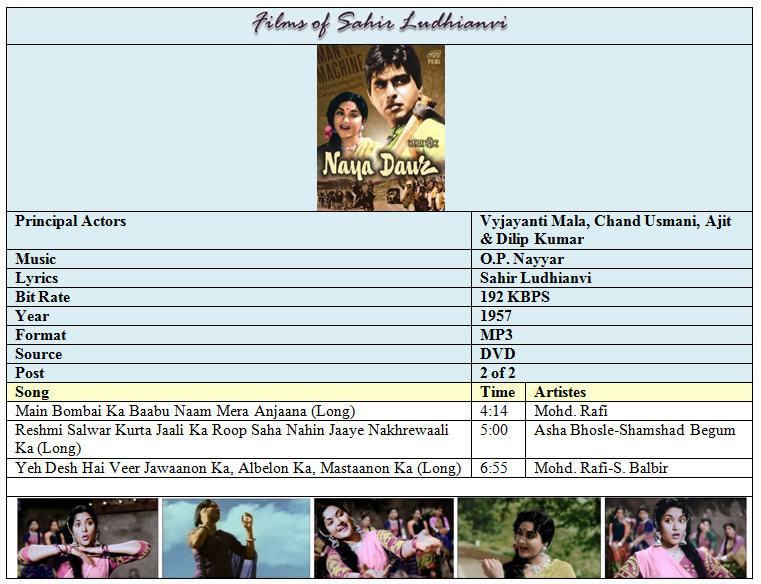
|
| swarapriya |
 Aug 27 2010, 01:28 AM Aug 27 2010, 01:28 AM
Post
#104
|
|
Dedicated Member  Group: Angels Posts: 15469 Joined: 8-January 08 Member No.: 36307 |
Pyaasa (1957)
(Note: Most of the following write up I have used in an earlier posting.) This probably is one of the most profoundly affecting movie ever made in India. Appropriately titled “Pyaasa”, it tells the story of a young poet’s thirst for love, recognition, and spiritual fulfillment. The movie portrays an artist’s isolation and craving for recognition through dappled imagery and some magnificent picturization of beautiful songs with literary rich lyrics. Based on a story written in 1947 called “Kashmakash”, writer Abrar Alvi comes up with a gem of a screenplay. Guru Dutt who acted, produced, and directed the movie changed the story on the very first day when the shooting began. Originally the story was about a painter. Guru changed the hero from the painter to a poet. A perfectionist, this was how apparently Guru Dutt worked. He never hesitated to make changes at the last minute. The movie originally was to star Nargis, Madhubala, and Dilip Kumar. Nargis backed out because she was unhappy with Guru Dutt because Sunil Dutt, her husband, was dropped from a movie Guru was producing and directing. The movie progressed well and canned even few reels but suddenly Guru decided to scrap the project quietly and didn’t even bother to inform Sunil Dutt about it. Madhubala backed out because she felt her experience with Guru Dutt from “Mr. & Mrs. ‘55” showed that he could be overpoweringly demanding and not easily satisfied. When both the heroines backed out, Mala Sinha was selected to play Nargis’ role and Waheeda was given the role that would have gone to Madhubala. For the first day of shooting when Dilip Kumar didn’t show up, Guru Dutt learned that Dilip didn’t want play the role because he thought it was going to be another “Devdas”. Guru then decided to cast himself in the role of the poet. Guru Dutt also changed the ending from what Abrar Alvi wrote. In the original story, the movie would have ended with Vijay (Guru) meeting Meena (Mala Sinha) for the last time. But when the distributors saw this, they felt that it was too gloomy. Guru shot the last scene with he and Waheeda in each others arms started going towards the distant sunset in search of a better life. Johnny Walker was originally cast to play Guru Dutt’s roommate (in the role of Shyam), kind of a negative role for Johnny. After several days of shooting, Guru changed his mind and cast Johnny as Sattar and took one of his assistant friends, Shyam Kumar, to play the role of Shyam. The movie was dedicated to Gyan Mukherjee whom Guru Dutt admired immensely. Mahmood played the role of young Ashok Kumar in “Kismat” that was directed by Mukherjee. That is where Guru Dutt initially met Mahmood. Guru offered Mahmood to play his older brother’s role in “Pyaasa”. Mahmood also appeared in Guru’s previous film C.I.D. These were before Mahmood found his groove as a comedian. For the important role of the publisher, Guru went back to his old friend Rehman. A fine actor, Rehman was not getting any decent offers. “Pyaasa” revived his career. For Guru’s previous four films (“Baaz”, “Aar Paar”, “Mr. & Mrs. ‘55”, and “C.I.D.”) O.P. Nayyar composed music. This time because of the backdrop of Calcutta, Guru Dutt decided to go with S.D. Burman as the music director. He worked with Burman before in “Baazi” and “Jaal” and as a team they were terrific together. S.D. was brilliant in capturing the magic of Bengal with gently lilting tunes and great background score that helped create the subtle atmosphere demanded by so many scenes. The background score was the same for each principal character in the movie. For example, in Meena’s (Mala Sinha) case, whenever she appeared on the screen, a harmonica was used to play a beautifully haunting tune. Incidentally the harmonica player was R.D. Burman. Sattar’s song “Sar Jo Tera Chakraaye” in “Pyaasa” was also composed by the young Burman, R.D. Recognizing the promise and talent, Guru offered R.D. his first job as a music director for his next project. After the completion of “Pyaasa”, Guru did start this project with R.D. as the music director, but after shooting few reels the movie was scrapped. R.D. used those recorded but unused songs for Mahmood’s first own production “Chhote Nawab”. By default it also became the first movie for which R.D. was the music director. Sahir Ludhianvi was selected to write lyrics. Much of the credit for the success the movie enjoyed goes to the immensely rich lyrics written by Sahir. Articulating political commentary with humanitarian compassion and blending it with the experience of tragedy was the undercurrent of many of the songs written for this movie. Many people believe that Sahir’s own unhappy romances set a pattern of expression for these songs. Sahir never forgot what “Pyaasa” and Guru Dutt did for his writing career. Many a times he acknowledged Guru to be the principal reason for opening up the emphasis on content rather than on form in creating songs for the movies. One of the things that made movie so great was the voices of Geeta Dutt, Hemant Kumar, and Mohd. Rafi. Every song they sang still lingers in your thoughts. But the song that symbolizes this movie is that atmospheric stunner, “Aaj Sajan Mohe Ang Laga Lo”. This probably is one of the greatest romantic moments ever filmed for a movie. Its sensuality is heightened by Geetaji’s mesmerizing voice that seem to oscillate by taking the listener between the earth and the heavens. A lovely interpretation of earthly divine love. Mala Sinha was a relatively newcomer to Hindi films but already acted in many Bengali movies. However, for Waheeda, this was the first movie which demanded her to exhibit her histrionics and emotional skills. Guru was very patient with her. Encouraging and assisting. Instilling confidence. The end result is that a real star was born with this movie. Restrained and understated performances became her trademarks for most of her career. This was the only second film for Waheeda Rehman. And her performance was simply brilliant as a prostitute with whom the hero finds solace and comfort. In such a demanding role, Waheeda gave an exceptional understated performance with effective emoting. She showed that she could be sultry and at the same time equally radiant. The photography of “Pyaasa” adds another dimension to the movie’s unprecedented achievements. Guru Dutt and the cameraman V.K. Murty use black and white light effects and shadows so effectively that they leave their alluring imprints in heart forever. Imagery of Christ is used as a symbolic narrative, an allegory, of Vijay’s sufferings. When Rehman is reading the story in the newspaper about the death of Vijay, Meena is holding an issue of the Life magazine whose cover is adorned by Jesus Christ on the cross. Like Jesus himself, Vijay resurrects. When he appears for his own commemoration meeting, he stands at the doorway hands stretched much like Jesus on the cross. In 2005, Time magazine voted “Pyaasa” as one of the 100 greatest movies in the world. A London-based magazine voted in 2007 Guru Dutt as one of the top 67 directors in the world. Quite a tribute to one of the great cinematic geniuses of Indian cinema. In 1977, exactly 20 years after “Pyaasa” was released, it was remade in Telugu as “Malle Puvvu”. These songs were posted earlier. Because of the number of songs, nazms, and verses this movie has, I will post them in four back-to-back separate posts. To start, here is the first set of songs … Attached image(s) 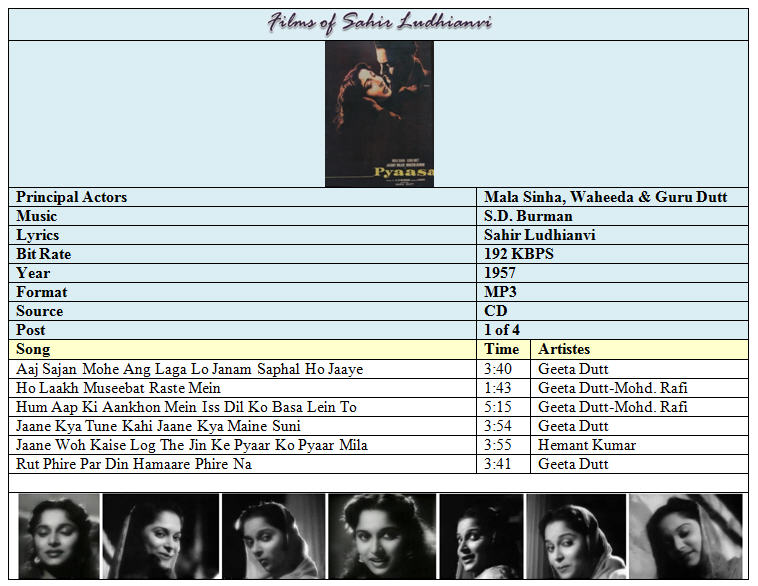
|
| swarapriya |
 Aug 27 2010, 01:39 AM Aug 27 2010, 01:39 AM
Post
#105
|
|
Dedicated Member  Group: Angels Posts: 15469 Joined: 8-January 08 Member No.: 36307 |
Continuing Songs from "Pyaasa (1957)" ...
Here are the next set of songs from this great album ... Attached image(s) 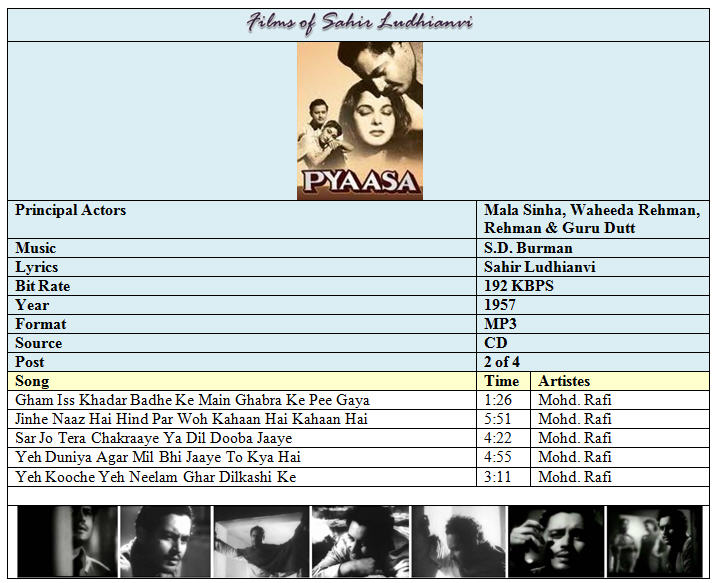
|
| swarapriya |
 Aug 27 2010, 01:51 AM Aug 27 2010, 01:51 AM
Post
#106
|
|
Dedicated Member  Group: Angels Posts: 15469 Joined: 8-January 08 Member No.: 36307 |
More Songs from "Pyaasa (1957)" ...
More songs from this great album. I am also including here a special version of "Aaj Sajan" with a fine introduction by Kalpana Lajmi. Lajmi is a niece of Great Guru Dutt and is a filmmaker in her own right. Her greatest achievement was "Rudaali" released in 1997. Now for the songs ... Attached image(s) 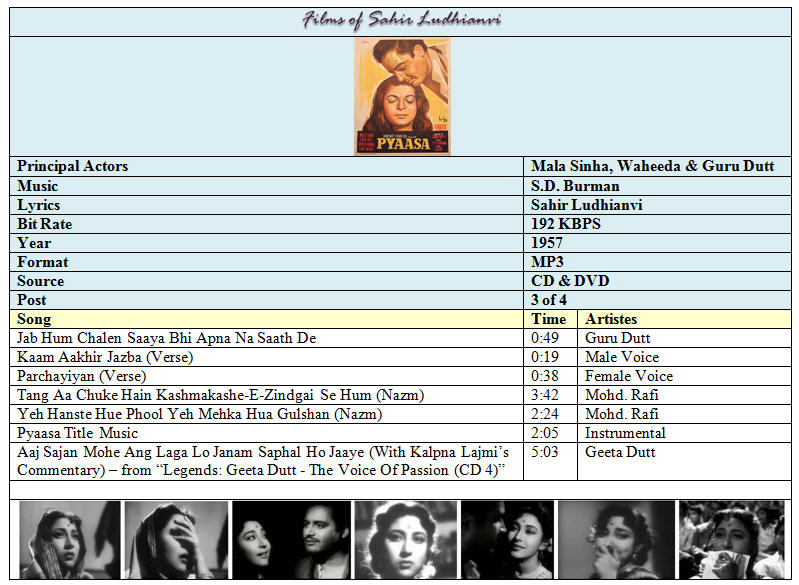
|
| swarapriya |
 Aug 27 2010, 02:01 AM Aug 27 2010, 02:01 AM
Post
#107
|
|
Dedicated Member  Group: Angels Posts: 15469 Joined: 8-January 08 Member No.: 36307 |
Concluding Songs from "Pyaasa (1957)" ...
I am including here some of the extended version songs from this beautiful film ... Attached image(s) 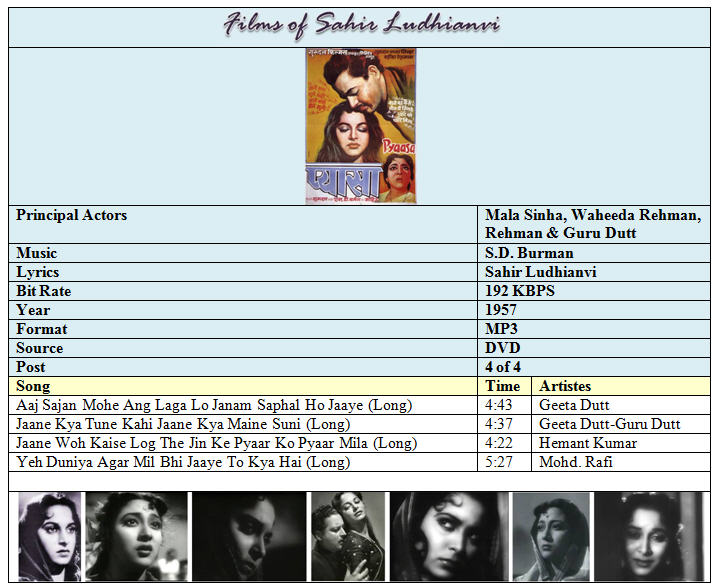
|
| swarapriya |
 Sep 1 2010, 11:50 PM Sep 1 2010, 11:50 PM
Post
#108
|
|
Dedicated Member  Group: Angels Posts: 15469 Joined: 8-January 08 Member No.: 36307 |
Tumsa Nahin Dekha (1957)
Finally here is the movie where real Shammi arrived. It was a long way coming but came he did and with such a thud that it made waves all over the Hindi film world. After this movie, for Shammi and his fans his subsequent films were never the same again. Under the guidance of his wife Geeta Bali, Shammi went through a complete metamorphism for this movie to give one last gasp try to save his professional carrier. With so many critics panning him to be another Raj Kapoor look-alike, he shaved his upper lip. He studied carefully why Elvis Presley and James Dean were so popular with youth all over the world. He groomed his hair Jimmy Dean style. He took a guitar and added twists and turns to his acting a la Elvis even though he could not play it. These changes earned in the industry the nick name of “Rebel Star” for Shammi, because of the changes he made for himself to appear as the star of the hit English movie, “Rebel Without a Cause (1955)” that starred Jimmy Dean. When "Tumsa Nahin Dekha" was released, people immediately embraced this new incarnation of Shammi. He was an overnight box-office sensation. Things in Bombay film world were never going to be the same anymore. This movie had a first-time director, Nasir Hussain. He was a popular writer for Filmistan Studios. One of his most popular story was Dev Anand-starrer "Munimji (1955)". Hussain also wrote the story and the screenplay for the movie. Its heroine, Ameeta was a protégé of the head of the Filmistan Studio. He was re-launching her with this movie. All the camera work, lighting, exposure, and publicity were carefully centered around her. Even the title of the movie was selected in praise of her when Tolaram Jalan, the studio head, ran a contest among his employees to come up with a name for the movie. But when the movie was released, people flocked theatres to watch mostly Shammi and listen to OP's mesmerizingly magical music. The movie's huge success was eminently aided by one of the best scores OP provided in his career until that time. The mantra was simple. The beat should be upbeat. The style should be snappy. It is this that helped the singing and swinging style for Shammi. If OP came up with riveting rhythms, Shammi became a perfect foil with his acrobatic dancing. For Hindi films, it was the dawn of a new hero. No more sighs. Just smiles. Rafi Saab’s incredibly beautiful voice helped Shammi also discover his groove. Every song from this film was a huge hit. Each one of them left a deep impression on its listeners. To aid OP were superb singing by Rafi Saab and Ashaji. Majrooh Saab wrote all of the lyrics except the title song. The title song was written by Sahir Saab. Originally Sahir Saab was signed to write the lyrics for the movie. He was coming off from a crowning achievement of penning lyrics for Guru Dutt's humane classic saga of a poet striving for recognition, "Pyaasa (1957)". He was in mood to write similar lyrics and was not ready for the type of lyrics this movie demanded. So Nasir Hussain quietly replaced Sahir Saab with Majrooh. Majrooh Saab did not disappoint. He was magnificent. The title song sung by Asha that I am including here was not in the movie. I am also including an extended version of the song "Sar Par Topi". This is a DVD rip I am uploading songs and a couple of specials in two back-to-back posts. Now for the details of the songs in the first post and the songs themselves. I am including a brief snippet where Shaami talks (in English) about his role in this movie ... This post has been edited by swarapriya: Sep 2 2010, 12:01 AM Attached image(s) 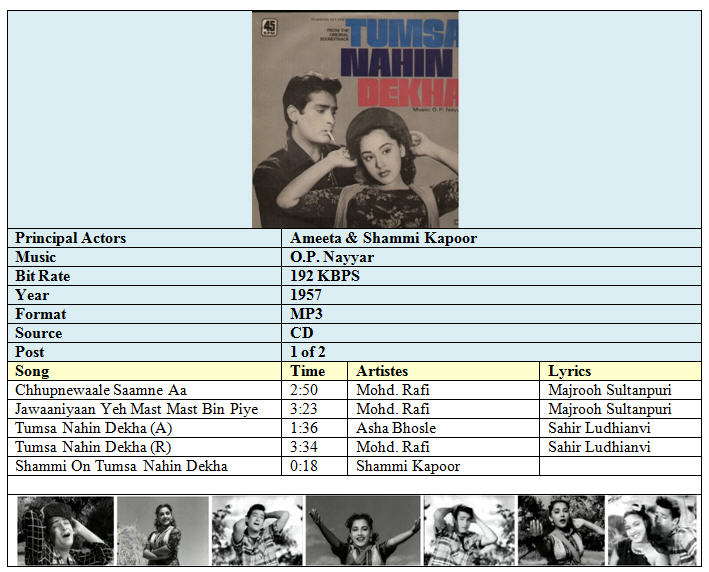
|
| swarapriya |
 Sep 1 2010, 11:59 PM Sep 1 2010, 11:59 PM
Post
#109
|
|
Dedicated Member  Group: Angels Posts: 15469 Joined: 8-January 08 Member No.: 36307 |
Concluding Songs from "Tumsa Nahin Dekha (1957)" ...
Here are the rest of the songs from this great album ... Attached image(s) 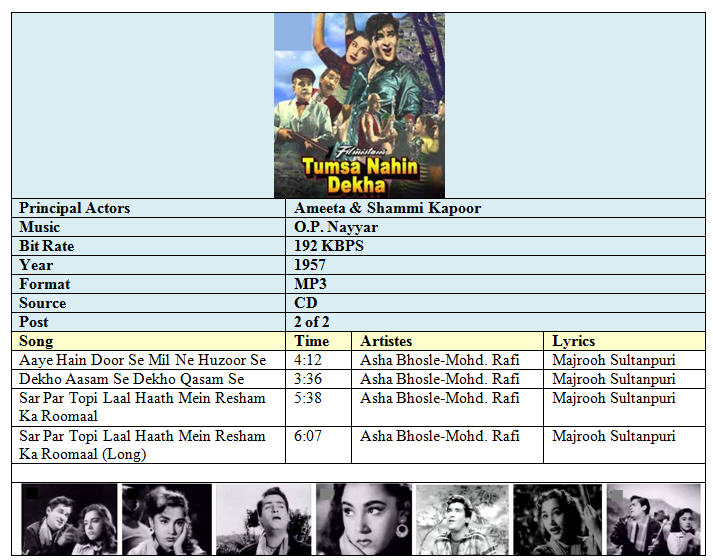
|
| nandi |
 Sep 7 2010, 07:36 PM Sep 7 2010, 07:36 PM
Post
#110
|
|
Dedicated Member  Group: Members Posts: 2565 Joined: 4-June 08 From: Illinois,USA Member No.: 55513 |
Angaarey (1954) Here is another beautiful album from the knock-out combination of Burmanda and Sahir Saab where every song is a melodious winner. All these songs are by the courtesy of the Forum members. Thank you. Now for the details of the songs and the songs themselves ... Thanks for this excellent album. Talat's solo and duet with Lata are worth the price of admission! nandi |
| surhall |
 Sep 7 2010, 07:54 PM Sep 7 2010, 07:54 PM
Post
#111
|
|
Dedicated Member  Group: Angels Posts: 6799 Joined: 4-November 03 From: Toronto-Canada Member No.: 86 |
sangeet ka safar have this for music lover & site रचनाकार: साहिर लुधियानवी » अक़ायद वहम है मज़हब ख़याल-ए-ख़ाम है साक़ी अक़ायद वहम है मज़हब ख़याल-ए-ख़ाम है साक़ी अज़ल से ज़हन-ए-इन्सां बस्त-ए-औहाम है साक़ी हक़ीक़त-आशनाई अस्ल में गुम-कदर्ह-राही है उरूस-ए-आगही परवरदह-ए-अबहाम है साक़ी मुबारक हो जाईफ़ी को ख़िरद की फ़लसफ़ादानी जवानी बेनियाज़-ए-इब्रत-ए-अन्जाम है साक़ी अभी तक रास्ते के पेच-ओ-ख़म से दिल धड़कता है मेरा ज़ौक़-ए-तलब शायद अभी तक ख़ाम है साक़ी वहाँ भेजा गया हूँ चाक करने पर्दे-ए-शब को जहाँ हर सुबह के दामन पे अक्स-ए-शाम है साक़ी dhall |
| swarapriya |
 Sep 7 2010, 10:31 PM Sep 7 2010, 10:31 PM
Post
#112
|
|
Dedicated Member  Group: Angels Posts: 15469 Joined: 8-January 08 Member No.: 36307 |
Angaarey (1954) Here is another beautiful album from the knock-out combination of Burmanda and Sahir Saab where every song is a melodious winner. All these songs are by the courtesy of the Forum members. Thank you. Now for the details of the songs and the songs themselves ... Thanks for this excellent album. Talat's solo and duet with Lata are worth the price of admission! nandi You're welcome Nandi. Cheers. -S |
| swarapriya |
 Sep 7 2010, 10:33 PM Sep 7 2010, 10:33 PM
Post
#113
|
|
Dedicated Member  Group: Angels Posts: 15469 Joined: 8-January 08 Member No.: 36307 |
sangeet ka safar have this for music lover & site रचनाकार: साहिर लुधियानवी » अक़ायद वहम है मज़हब ख़याल-ए-ख़ाम है साक़ी अक़ायद वहम है मज़हब ख़याल-ए-ख़ाम है साक़ी अज़ल से ज़हन-ए-इन्सां बस्त-ए-औहाम है साक़ी हक़ीक़त-आशनाई अस्ल में गुम-कदर्ह-राही है उरूस-ए-आगही परवरदह-ए-अबहाम है साक़ी मुबारक हो जाईफ़ी को ख़िरद की फ़लसफ़ादानी जवानी बेनियाज़-ए-इब्रत-ए-अन्जाम है साक़ी अभी तक रास्ते के पेच-ओ-ख़म से दिल धड़कता है मेरा ज़ौक़-ए-तलब शायद अभी तक ख़ाम है साक़ी वहाँ भेजा गया हूँ चाक करने पर्दे-ए-शब को जहाँ हर सुबह के दामन पे अक्स-ए-शाम है साक़ी dhall Thank you veru much Dhallji for the poem. Cheers. -S |
| swarapriya |
 Sep 8 2010, 06:48 AM Sep 8 2010, 06:48 AM
Post
#114
|
|
Dedicated Member  Group: Angels Posts: 15469 Joined: 8-January 08 Member No.: 36307 |
12 O'Clock (1958)
Here is OP's beautiful album in which Sahir, fresh from his success with "Naya Daur (1957)" resulting in his collaboration with OP, had an opportunity to write a couple of songs for this album. This album is all Geeta. Exuberant. Effervescent. Exhilarating. Song of the album, my dear favorite one, is the song "Kaisa Jaadoo Balam Tu Ne Daara". Here is this and rest of the songs from an original soundtrack album ... Attached image(s) 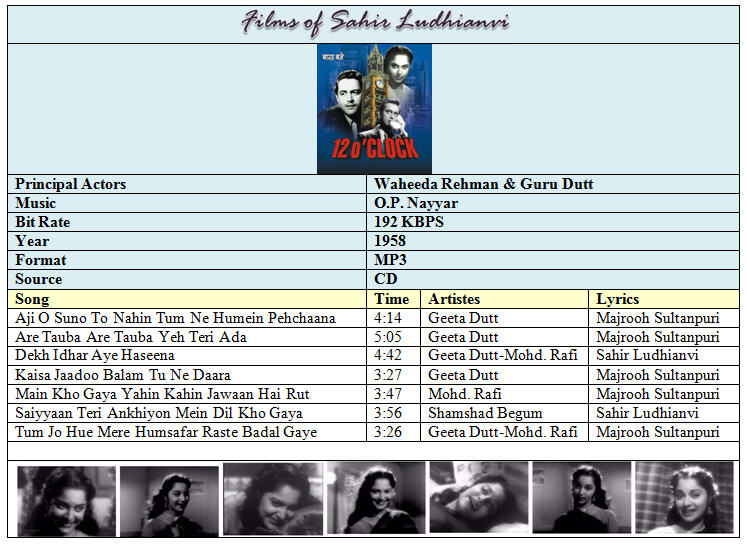
|
| roxyman |
 Sep 14 2010, 11:58 AM Sep 14 2010, 11:58 AM
Post
#115
|
|
Member  Group: Members Posts: 131 Joined: 24-February 07 From: Australia Member No.: 11619 |
thanks for great old songs specially Munimji (1955) the song i have been looking for "Jeevan Ke Safar Mein Raahi Milte Hain Bichhad Jaane Ko"
|
| swarapriya |
 Sep 15 2010, 09:26 AM Sep 15 2010, 09:26 AM
Post
#116
|
|
Dedicated Member  Group: Angels Posts: 15469 Joined: 8-January 08 Member No.: 36307 |
|
| swarapriya |
 Sep 15 2010, 09:41 AM Sep 15 2010, 09:41 AM
Post
#117
|
|
Dedicated Member  Group: Angels Posts: 15469 Joined: 8-January 08 Member No.: 36307 |
Phir Subah Hogi (1958)
This probably is one of the best Hindi movies, aside from Guru Dutt’s “Pyaasa (1957)”, ever made in India that dealt with human dignity and a plea for humanitarian compassion. There were so may facets to this movie that combine to make it a great viewing experience. Watching it makes it a relentless as well as an unforgettable sensual experience at the same time. Let us look into some factors that made this a triumph in film making … The movie was based on the famous Russian novel “Crime and Punishment” written by Fyodor Dostoevsky. It was published in 1866. But the story of this movie extends the novel as an emotional plea for social justice and makes a compelling and compassionate political commentary. On one side an independent India saw the attraction of big cities sprawled with excitement, jobs, wealth, and opportunities. On the other side it also saw the greedy sprouting of crime, slums, injustice, and exploitation and because of it the disillusionment that it brought along. The movie shows this latter part of post independence India. The movie has provided Raj Kapoor an opportunity to exhibit his talents as an actor. He pulls off this with a heart hugging performance where his role demands to react to not only external conflicts but that brings out internal insecurities to the surface. It calls for him to exhibit his histrionics to show the suffering of guilt and its toll of emotional turmoil. Raj carries this with unparalleled aplomb. This probably was one of the most wonderfully orchestrated insightful performances of his illustrious career that showcases his skill as an actor. Raj Kapoor originally wanted Shankar & Jaikishan to provide music for this film. However, Sahir was adamant about having someone compose music who read Dostoevsky’s novel because he strongly felt that only that person could provide a convincing musical score. Khayyam was Sahir’ choice. Because of Raj’s objections, to show that he has the required abilities to deliver, Khayyam composed six different ways of the title song. Raj was so impressed that he agreed Khayyam to be the music director and left up to him to choose the tune he liked the best. The musical score of this film happens to be not only one of the memorable ones ever scored by Khayyam but also one of the unforgettable ones put together for an Indian movie. Almost every song sparkles like a real gem. Especially the title song done by Asha and Mukesh with that beautiful haunting melody, to some of the compelling words penned by Sahir, and evocatively picturized in the movie stays with you forever. Khayyam never got his due as a music director that spanned a 50-year professional career. Yet songs from many of his movies have stood the test of time and have been perennial pleasers. Sahir was coming off from the great success he enjoyed just about a year back with Guru Dutt’s classic “Pyaasa”. Here he was presented with another opportunity to extend similar sentiments, pathos, and sufferings through the powerful words he was commissioned to construct. And he did this with unparalleled magnificence engulfed with enormously grief stricken melancholy. It is clear that Sahir was not happy with what was going on in the society in the post independent India. The despair, disgust, decadence, deceit, and disillusionment spilled over from the message passed on by “Pyaasa” penetratingly permeates this movie as well. In the song “Chin-O-Arab” he laments “Rehne Ko Ghar Nahin Hai”. He complains to God in the song “Aasman Pe Hai Khuda” that “Aaj Woh Iss Taraf Dekhta Hai Kum”. Even amidst such hopelessness, a ray of hope that is always there, like the burst of sunshine amidst clouds, because in the end he concludes that “Woh Subah Kabhi Toh Aayegi”. Poets like Sahir, whose poetry had that intellectual element and has clamored for people to arise from the sultry smugness, only happen perhaps once in a millennium. Interestingly, for all its glorified reality the movie never got any awards. So many people who were responsible to make this happen went unrecognized. Most of the awards for 1958 went to Bimal Roy’s lyrical poem of love, “Madhumati”. Best actor award went to Dev Anand for “Kala Pani”. The movie was not only nominated or considered for any awards , but also was a commercial failure. In the end the movie which should have been remembered in the book of film history as a memorable masterpiece ended up as another forgotten chapter. I am uploading these songs in back-to-back two posts. The song "Woh Subah Kabhi To Aayegi" in all its parts is uploaded in the second post. Here are the songs in the first post ... Attached image(s) 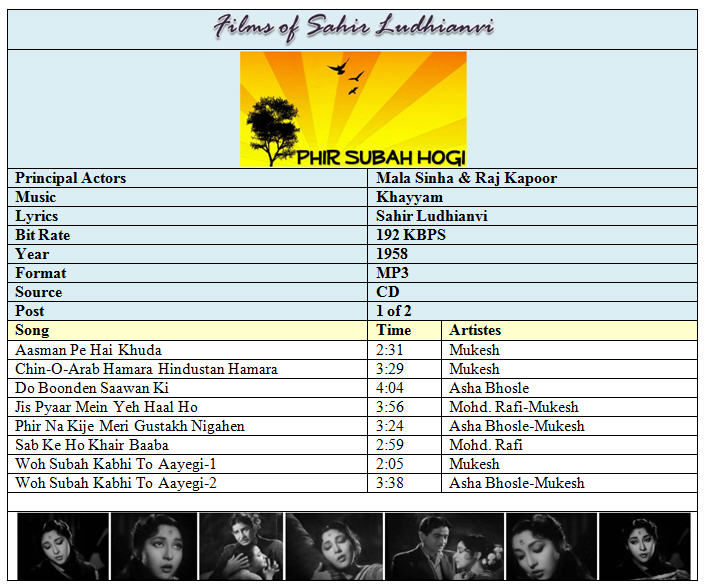
|
  |
1 User(s) are reading this topic (1 Guests and 0 Anonymous Users)
0 Members:

|
Lo-Fi Version | Disclaimer | HF Guidelines |  |
Time is now: 19th July 2025 - 03:02 PM |
Invision Power Board
v2.1.7 © 2025 IPS, Inc.
Licensed to: Hamaraforums.com









